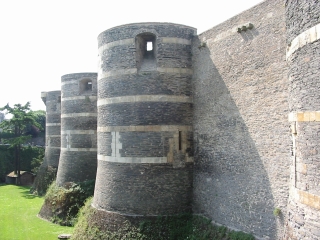So, when we were planning this project of a year-long “visit” to all of the regions of France, we first had to define our regions. Would we use the administrative regions that have existed since 2016, or the regions from 1982 to 2016, or even the historic provinces? Ultimately, thinking of the project in culinary terms, we decided on a blend that made sense to us and worked for our schedule.
Some of our regions are old school, some are cultural and some – like Pays de la Loire -reflect the current administrative boundaries.
This region, along with the Centre-Val de Loire, is called the “Garden of France” and probably is most famous for its fabulous chateaux. During the Renaissance, the French royal court shifted to the Loire Valley, where kings and wealthy courtiers constructed these elaborate palaces that are now among the top tourist attractions in France.

Last year, when we were planning a real visit to France, a cycling trip to the Loire Valley had been on our agenda. Then April in Michigan happened (more blizzards) and we decided to go as far south in France as possible, so most of our 2018 trip was spent along the Mediterranean. Cycling the Loire Valley remains an unrealized goal, and one we hope to accomplish on our next visit.
The most visited Loire chateaux are in the Centre-Val de Loire region, so we’ll take up this topic again when we “go” there in two weeks.
Meanwhile, the Pays de la Loire offers a transition from last week’s visit to Bretagne (Brittany) because part of it is historically and culturally Breton.
The capital of the region and the sixth-largest city in France, Nantes is culturally and historically part of Brittany. The Dukes of Brittany made it their primary residence, and their castle is one of the top attractions of the city.

Nantes was a major port for the slave trade in the 18th century. A meditative public park commemorates the victims of this disturbing time in French history and also highlights ongoing global struggles against slavery.
Nantes is now considered one of the best cities in France for quality of life, and a particularly appealing destination for a family vacation with kids, although it is in no danger of eclipsing Disneyland Paris (seriously, on our Paris-Dublin flights last year, every kid on board was either going to or coming from Disneyland).
Jules Verne was born in Nantes, and city pays homage to the pioneering novelist with an amusement park inspired by his adventure stories. Les Machines de L’Île looks like fun for kids of all ages. Who wouldn’t want to take a ride in a mechanical elephant or a giant bug on a carousel?

Sailing upriver from Nantes (and a river barge trip is a popular way to see the Loire, with many operators offering excursions), you will find a unique, quirky and nearly unknown attraction on the isle of Chalonnes-sur-Loire. Le Lenin Cafe is a museum to the Soviet founder and a celebration of revolutionary ideals. The establishment offers food, music and accommodations in accordance with its principles of resistant tourism. There is no information in English on this place.
Continuing on upstream, we come to another area of historical importance. Angers was the original seat of the Plantagenet dynasty that ruled England and parts of France for three centuries. Again, I’ll recommend historian Dan Jones’ fascinating book The Plantagenets: The Warrior Kings and Queens Who Made England. We will continue to meet up with them in our tour.

At the eastern edge of the region, we come to the large and important village of Saumur. Its wine trade provided the setting for Honoré de Balzac’s novel Eugénie Grandet, an excellent novel (albeit hard to find in print) capturing provincial life in early 19th century France.
Saumur brings us (finally!) deep into a French wine-growing region, which we’ll explore next week in the culinary edition.

